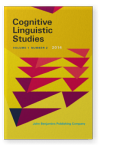Vol. 1:2 (2014) ► pp.313–328
Formant frequency characteristics in Palestinian Arabic-speaking aphasics
The aim of this paper is to examine the acoustic characteristics of Arabic vowels as produced by Palestinian Arabic-speaking Broca’s aphasics compared to normal speakers. Five subjects diagnosed with Broca’s aphasia and five normal speakers residing in the West Bank participated in this study. The subjects produced 240 vowel tokens of the eight Arabic vowels (/i:/, /i/, /e:/, /a:/, /a/, /o:/, /u:/ and /u/,). The samples were analyzed using PRAAT and the formants F1 and F2 of the eight Arabic vowels were measured. F1 and F2 values were compared to the data in the literature. Comparisons among speakers of Palestinian Arabic indicated that Broca’s aphasics’ formant frequencies were significantly different to those of normal speakers, showing that formant frequencies of F1 and F2 are generally higher among Broca’s aphasics compared to the control group. Furthermore, the findings reveal that the acoustic vowel space of Broca’s aphasics is more centralized compared to the control subjects. The results also indicate that Broca’s aphasics were able to maintain the phonemic contrast between the long and short vowels. In general, the results may contribute to neurolinguistic research across different languages, especially given that Palestinian Arabic is studied significantly less than other Arabic dialects. Furthermore, the results may have clinical applications when evaluating and/or treating Palestinian Arabic-speaking Broca’s aphasics.
